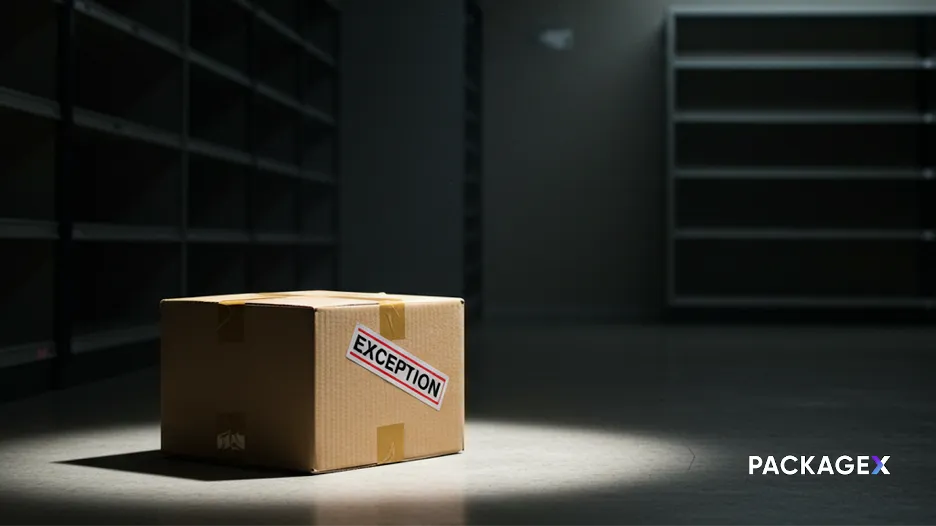Corporate mailrooms handle package exceptions daily - items that can't follow normal delivery workflows and require additional research before reaching recipients. Understanding how to manage these efficiently saves time, reduces costs, and improves service quality.
What Are Package Exceptions?
Package exceptions occur when deliveries can't progress through standard mailroom processes. These items get flagged for manual handling because something prevents normal delivery completion.
Common exception triggers include:
- Generic addressing with no recipient name or department details
- Items requiring security clearance before delivery
- Packages delivered to the wrong company addresses by carriers
- Recipients no longer employed at the organization
- Oversized items needing special equipment or assembly coordination
Most Common Exception Scenarios Corporate Mailrooms Face
Generic Addressed Items (Most Frequent)
What happens: The package arrives addressed only to "Company Name" without a purchase order, reference number, packaging slip, or identifiable sender patterns.
Why it's problematic: Without leading indicators - the values and details that help staff make routing decisions - packages sit in limbo. Sometimes, packing slips are inside boxes, requiring security clearance to open and identify contents.
Real impact: Staff waste hours trying to match generic packages to potential recipients across multiple departments.
Security Clearance Requirements
What happens: Items that aren't business-appropriate are delivered to executives or staff. This includes anything from knives and unusual items to packages from banned senders who've previously sent threatening materials.
Why it matters: High-profile executives at companies receive inappropriate items regularly. Security teams need documented proof of delivery and the identity of the person responsible for legal action, such as restraining orders or cease and desist orders.
Process challenge: Coordinating between the mailroom, security, and legal teams while maintaining the chain of custody documentation.
Damaged or Broken Items
What happens: Packages arrive visibly damaged, contents broken, or boxes compromised during shipping.
Staff burden: Requires documentation, photos, carrier coordination, and recipient notification before delivery or return processing.
Carrier Delivery Errors
What happens: UPS, FedEx, or other carriers deliver packages to your facility that belong to entirely different companies.
Hidden cost: Your team spends time researching and coordinating returns for items that should never have reached your dock to stock, then dealing with carrier pickup and reporting.
Oversized Items Requiring Coordination
What happens: Large furniture or equipment arrives requiring the facilities team's assembly, installation, or special delivery coordination.
Example: Multi-box standing desk shipments that require coordination with the facilities team for delivery instead of direct delivery to the recipients.
Complexity: Coordinating timing between multiple teams, proper equipment, and installation schedules.
The Real Cost of Poor Exception Handling
A central corporate campus processing 1,000+ packages daily calculated that each exception costs $47 in staff time:
- 30 minutes mailroom research ($15/hour) = $7.50
- 20 minutes HR system lookups ($25/hour) = $8.33
- 45 minutes coordination emails ($35/hour) = $26.25
- Lost productivity from delivery delays = $4.92
With 50 exceptions weekly, that equals $122,200 annually in wasted time - not including the stress and frustration for receiving teams managing these disruptions.
The Rework Problem
When HR systems aren't updated and items are delivered to terminated employees, staff must retrieve the packages after 1-2 weeks if they are uncollected. They then bring the packages back to central receiving and discover that the delivery shouldn't have happened initially. This unnecessary rework compounds inefficiency.
How Leading Mailroom Operations Handle Each Exception Type
Generic Addressed Items
Smart approach: Use leading indicators and system integration to identify recipients. When a package has a PO number, automatically lookup the purchaser in ERP systems. If Kyle is in purchasing orders for Rishi, the system assigns delivery to Rishi automatically.
Key insight: Even eliminating 20% of manual research through automated lookups provides significant value.
Security Issues
Systematic method: Create clear exception categories with defined response protocols:
- Immediate delivery after a basic scan
- 24-hour security review with recipient notification
- Return to sender with security documentation
Key insight: Consistent categorization eliminates guesswork and accelerates decision-making.
Employee Status Verification
Automated solution: Real-time integration with HR databases using 90-day employee record retention policies. Systems sync live data and alert staff when matches occur for terminated employees. Do not deliver; start the return/exception process automatically.
Key insight: Automation prevents unnecessary delivery attempts and reduces rework.
Oversized Items
Coordination approach: Treat large deliveries like scheduled appointments. Recipients and facilities teams get advance notice, proper equipment gets reserved, and delivery windows get coordinated.
Key insight: Make facilities teams part of the solution rather than struggling with inadequate equipment.
How Companies Like PackageX Are Solving Exception Management
Modern mailroom management platforms like PackageX have built dedicated exception workflows with logic automations that handle problems systematically rather than case-by-case.
For Generic Items: PackageX uses AI-powered scanning to extract available information and cross-reference corporate databases automatically. The system can pull PO numbers, match vendor patterns, and suggest routing based on historical data.
For Security Issues: PackageX creates automatic alerts when items need security review. Recipients get notified about delays, security receives clear instructions, and everything stays documented. Items don't disappear into security limbo.
For Employee Verification: PackageX connects directly to HR databases with real-time visibility. When packages arrive for terminated employees, the system flags them immediately and starts return processes automatically.
For Addressing Issues: PackageX catches addressing problems before they become exceptions by using leading indicators from other systems. The system can locate recipients by cross-referencing purchase orders, vendor relationships, and delivery patterns.
For Large Items: PackageX identifies weight and size requirements during intake, coordinates with facilities teams to schedule proper equipment, and manages delivery windows automatically.
The key difference is that companies like PackageX treat exceptions as normal workflow components instead of disruptions. Their systems expect problems and handle them systematically rather than leaving mailroom staff to figure solutions out individually.
This approach eliminates scattered emails, phone calls, and lost time that make exceptions expensive. Everything gets documented, nothing falls through cracks, and the entire process becomes predictable instead of chaotic.
Bottom Line for Mailroom Operations
Package exceptions don't have to consume disproportionate staff time or create operational headaches. The most effective approach involves:
- System integration that provides leading indicators for routing decisions
- Automated workflows that handle routine exception scenarios
- Clear escalation paths for complex cases requiring human judgment
- Complete documentation for accountability and continuous improvement
Mailrooms using systematic exception management report significant improvements in efficiency, staff satisfaction, and service quality. The technology exists to transform exception handling from reactive problem-solving into proactive workflow management.



%20Process%20Flow.webp)
